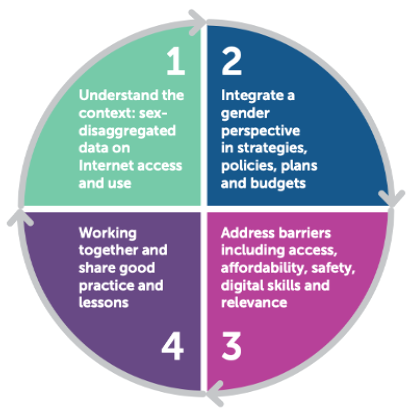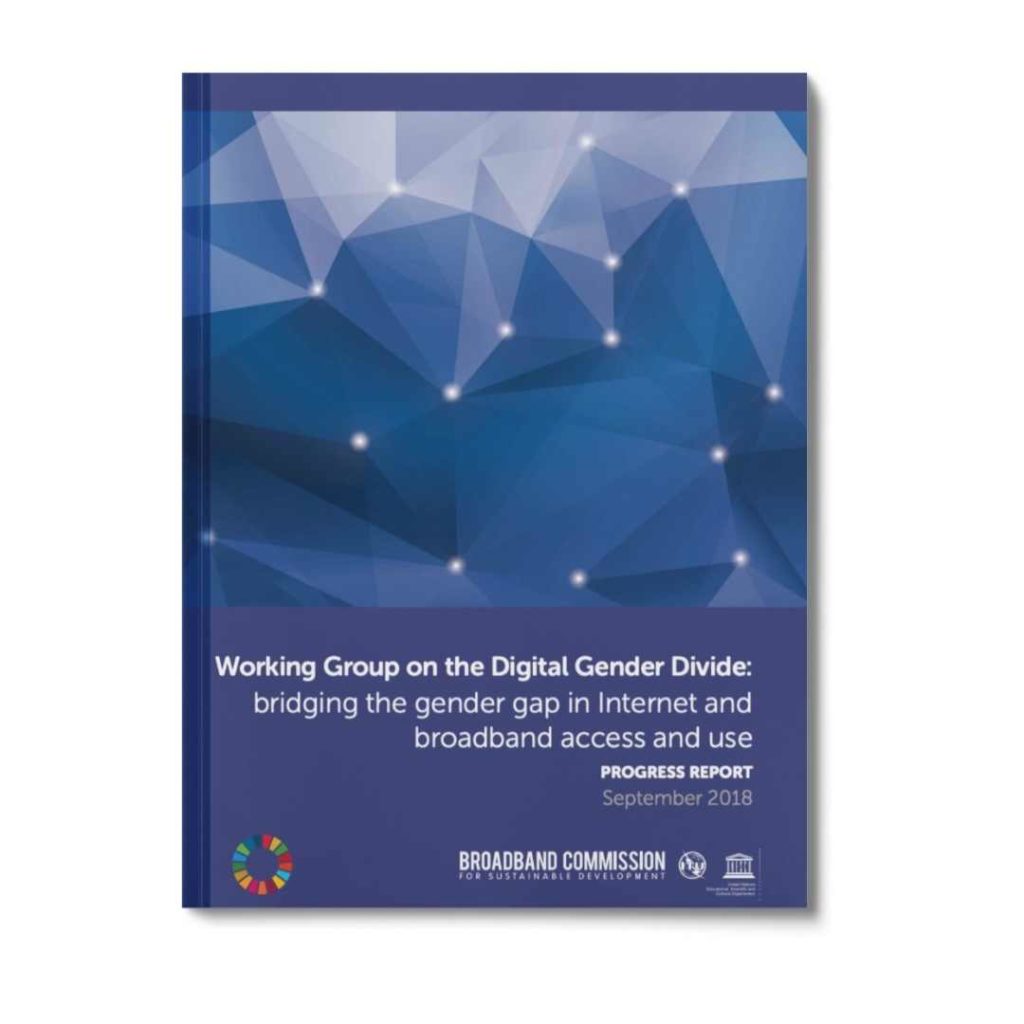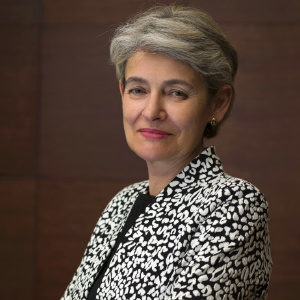How can we bridge the gender digital divide?
The Broadband Commission Working Group on the Digital Gender Divide was launched to further the work of the 2013 Working Group on Broadband and Gender, by helping to reduce the gender gap in Internet and broadband access and use. Co-Chaired by Mr. Mats Granryd, Director General of GSMA, and Ms. Irina Bokova, Director-General of UNESCO, the Commission’s 2017 Working Group on the Digital Gender Divide brought Commissioners and experts together to address barriers to women’s access and use of the Internet from a multistakeholder perspective.
Setting the Stage
The Global Gender Digital Divide
According to the ITU, between 2013 and 2016 the global Internet user gender gap grew from 11% to 12%. A widening digital gender gap has significant implications in terms of women’s empowerment and development as well as for societies, businesses and economies.
As a result, effective, tangible and measurable action is now essential and urgently needed from a wide range of different stakeholders to overcome the digital gender gap in access to ensure that women can also benefit from the developmental capacity of information and communication technologies (ICTs).
The Way Forward
Conclusions and Recommendations
The barriers preventing women from accessing and using the Internet are complex, varied, diverse, and interrelated. The Working Group’s 2017 report, titled Recommendations for action bridging the gender gap in internet and broadband access and use, uses relevant data on the digital gender gap to determine a baseline of the gender digital divide landscape before setting out actionable recommendations for to close the divide. These recommendations help clarify the complementary roles of different actors, including governments and policymakers, the private sector, inter-governmental organizations, NGOs, and academia and research institutions as the Working Group believes that the digital gender divide can only be bridged effectively by coordinated actions.
Targeted action by a range of stakeholders is required to address the gender gap in Internet access and use. This report sets out recommended actions that stakeholders should take to help deliver on internationally agreed goals and commitments which aim to bridge gender digital divides and to support sustainable development.
Key Recommendations for Action

The recommendations in this
Report, which are the outcomes of a collaborative and multi-stakeholder process, relate primarily to overcoming the barriers women face when accessing and using the Internet and broadband.
The following recommended actions fall into the four groups pictured here and are outlined below.
- Collecting, analyzing, and tracking data: the collection of robust, reliable, accurate, and timely sex-aggregated data is a crucial step in understanding the gender digital divide and measuring progress in addressing the issue
- Researching women’s access to and use of the Internet: The Working Group calls on stakeholders to research women’s access to and use of the Internet
to improve understanding of the needs, circumstances, and preferences of women in different local contexts, and the factors limiting women’s access to and use of the Internet, including cultural and social norms. - Publishing and sharing data and research: The pace of technological development that characterizes ICTs means that flexible and responsive polices and strategies are required which are driven by accurate, up-to-date information that is shared between stakeholders. The Working Group recommends that sex- disaggregated data and research should be published and shared among stakeholders in a safe and secure manner
- Establishing gender equality targets for Internet and broadband access and use: The Working Group calls on stakeholders to ensure that ICT/broadband access targets are included in gender equality and other related strategies, policies, plans and budgets. To ensure consistent action and progress, it further recommends that stakeholders should implement clear accountability structures to ensure targets are delivered and women are supported in accessing and using the Internet and broadband.
- Assessing strategies, policies, plans and budgets for gender equality considerations: The Working Group recommends that stakeholders use gender analysis tools to assess and develop strategies, policies, plans and budgets to ensure that gender equality considerations are sufficiently reflected and prioritised
- Consulting and involving women as well as relevant local communities
and experts: To ensure that policy development is centered on women and their needs in diverse contexts, the Working Group recommends that stakeholders consult and involve women and local communities, gender equality advocates and experts, as well as researchers and relevant NGOs, from the outset in the development of strategies, policies, plans and budgets.
- Improved understanding of affordability issues: The Working Group recommends that stakeholders investigate the ways in which men and women from diverse population segments are impacted by affordability issues and develop strategies for achieving affordable access based on this understanding.
- Innovating to reduce the cost of devices and services: The Working Group recommends that stakeholders work to reduce the cost of devices for accessing the Internet, and of data, so that access becomes more affordable to women, particularly those with lower incomes. This can be supported through policy and regulatory measures, the design of products and services, and technical and/or market innovation.
- Improving network coverage, capacity and quality: The Working Group recommends that stakeholders should collaborate and support efforts to increase network coverage, capacity and quality, particularly in underserved areas where a significant proportion of the population are women.
- Providing public access facilities: The Working Group recommends that stakeholders should support and invest in the provision of safe and accessible public access facilities to serve women.
- Researching and understanding threats: The Working Group recommends that stakeholders conduct research on the threats pertaining to women’s ICT use, as well as cultural and social norms, that prevent women from accessing and using the Internet in different regions and social and cultural contexts.
- Increasing awareness of threats and how they can be addressed or reduced: The Working Group recommends that stakeholders make use of awareness campaigns, digital literacy programmes and/or formal education programmes/ curricula to raise awareness of the threats that prevent women from accessing and using the Internet, and how they can be addressed or reduced.
- Developing safety applications and services: The Working Group recommends that stakeholders invest in applications and services that make it safer for women to access and use the Internet, while addressing issues of harassment, abuse and violence
- Strengthening protection measures and reporting procedures: The Working Group recommends that stakeholders strengthen measures to protect women against ICT-mediated abuse and harassment; including through legal and policy frameworks that recognise and address ICT-mediated abuse, harassment and fraud, and through measures that promote and simplify access to justice
- Understanding women’s needs: The Working Group recommends that stakeholders ensure that digital literacy and capacity-building initiatives consider women’s needs, interests and local contexts in order to encourage strategic and meaningful use of the Internet
- Investing in education and capacity-building initiatives: The Working Group recommends that stakeholders invest in public education and capacity-building initiatives that pay particular attention to increasing women’s digital literacy
and confidence, including women across all levels of education, income, and familiarity with ICTs and the Internet. - Developing skills and confidence: The Working Group recommends that stakeholders should support the development of online content and services that are accessible to women with limited literacy, language and ICT-related skills, and confidence; and should ensure that women with lower literacy levels are included in the pilots and user testing of these services, including online government content and services.
- Supporting educators: The Working Group recommends that educators, teachers and local leaders should be trained to use tools and understand the benefits of delivering digital skills training to women in their communities; that stakeholders should invest in pre- and in-service training of teachers and educators to support their ongoing learning and development; and that the number of female teachers of ICT across all levels of education should be increased.
- Supporting and promoting female role models: The Working Group recommends that female role models should be promoted as leaders and Internet users within communities and amongst staff in decision-making positions.
- Building awareness: Since a lack of perceived value can be a barrier to Internet access and use, the Working Group recommends that stakeholders help raise awareness of the potential benefits that can be achieved through women’s access to and use of Internet-enabled content, applications, and services.
- Developing relevant content and services: To ensure women can benefit from the development of relevant content and services, and can also participate
in their production, the Working Group recommends that stakeholders encourage and participate in the development of an ecosystem of quality, non- stereotypical services, applications, and content relevant to women which are designed with an understanding of women’s wants and needs. - Consulting and engaging women: A better understanding of the wants and needs of diverse groups of women, as distinct from men, will help stakeholders improve the relevance of content, applications, and services to women’s needs. The Working Group recommends that stakeholders involve women from diverse backgrounds, including those in low income groups and those who do not currently make use of ICTs, in the design, testing and iteration of content, applications, and services.
- Develop and share tools, guidelines, case studies and other materials which can support national and international efforts to address the digital gender gap
- Support and encourage multi-stakeholder cooperation and sharing of expertise in national and international efforts to address the digital gender gap.
- Women’s digital inclusion can help to catalyse broader gender equality in social, economic and political dimensions — benefiting not only women themselves, but also their communities and the broader economy.
The Working Group Model
Composition and Activities
- H.E. Dr. Abdulaziz Al Ruwais, Communications and Information Technology Commission (CITC), Saudi Arabia
- Mr. Börje Ekholm, Ericsson
- Mr. Kevin Martin, Facebook
- Baroness Beeban Kidron, Filmmaker and Founder of 5Rights
- Mr. Amir Dossal, Global Partnerships Forum
- Mr. Luis Alberto Moreno, IADB
- Mr. Rupert Pearce, Inmarsat
- Mr. John Galvin, Intel
- Mr. Houlin Zhao, International Telecommunication Union (ITU)
- Dr. Dato Lee Yee Cheong, ISTIC
- Dr. Speranza Ndege, Kenyatta University
- Prof. Gloria Bonder, Latin American Postgraduate Institute of Social Sciences
- Mr. Paul Mitchell, Microsoft
- Mr. Rajeev Suri, Nokia
- Dr. Nasser Marafih, Ooredoo
- Dr. Kathy Calvin, UN Foundation
- Ms. Phumzile Mlambo-Ngcuka, UN Women
- Mr. Jean-Yves Charlier, VimpelCom Ltd.
- Mr. Francis Gurry, World Intellectual Property Organization (WIPO)
- Ms. Caren Grown, Ms Samia Melhem, The World Bank
- Ms. Chat Garcia Ramilo, Association for Progressive Communications (APC)
- Ms. Helani Galpaya, LIRNEasia
- Ms. Sonia Jorge, Alliance for Affordable Internet (A4AI) and Web Foundation
- Ms Ann Mei Chang
The Broadband Commission Working Group on the Digital Gender Divide was established in March 2016 in Dubai, UAE. On 15th March 2017, the Working Group launched its report “Recommendations for action: bridging the gender gap in Internet and broadband access and use” during the Annual Spring Meeting of the Broadband Commission, held in Hong Kong, SAR of China.
- Press Release : UN Broadband Commission: Time for a “New Deal” if Broadband is to reach everyone, everywhere
- Press Release : New Broadband Commission call to action provides guide to close digital gender gap
- Photos from the meeting: Flickr
Focus Area
Outcome Resources
Co-Chairs
Mr. Mats Granryd
Director General, GSMA
&
Ms. Irina Bokova
Director General, UNESCO
Broadband Advocacy Targets
SDGs











